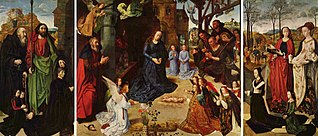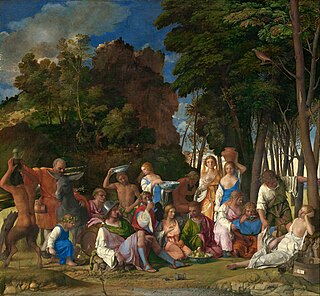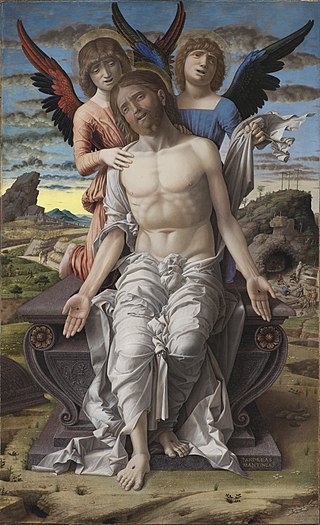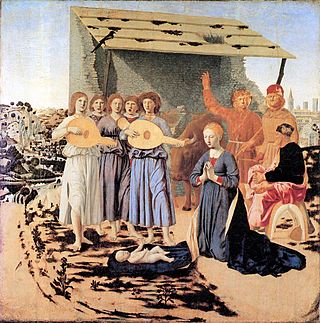
In the Christian tradition, a nativity scene is the special exhibition, particularly during the Christmas season, of art objects representing the birth of Jesus. While the term "nativity scene" may be used of any representation of the very common subject of the Nativity of Jesus in art, it has a more specialized sense referring to seasonal displays, either using model figures in a setting or reenactments called "living nativity scenes" in which real humans and animals participate. Nativity scenes exhibit figures representing the infant Jesus, his mother, Mary, and her husband, Joseph.

The Adoration of the Magi or Adoration of the Kings is the name traditionally given to the subject in the Nativity of Jesus in art in which the three Magi, represented as kings, especially in the West, having found Jesus by following a star, lay before him gifts of gold, frankincense, and myrrh, and worship him. It is related in the Bible by Matthew 2:11: "On entering the house, they saw the child with Mary his mother; and they knelt down and paid him homage. Then, opening their treasure chests, they offered him gifts of gold, frankincense, and myrrh. And having been warned in a dream not to return to Herod, they left for their own country by another path".

BartolomeoMontagna was an Italian Renaissance painter who mainly worked in Vicenza. He also produced works in Venice, Verona, and Padua. He is most famous for his many Madonnas and his works are known for their soft figures and depiction of eccentric marble architecture. He is considered to be heavily influenced by Giovanni Bellini, in whose workshop he might have worked around 1470. Benedetto Montagna, a productive engraver, was his son and pupil and active until about 1540. He was mentioned in Vasari's Lives as a student of Andrea Mantegna but this is widely contested by art historians.

The Holy Family consists of the Child Jesus, the Virgin Mary and Saint Joseph. The subject became popular in art from the 1490s on, but veneration of the Holy Family was formally begun in the 17th century by Saint François de Laval, the first bishop of New France, who founded a confraternity.

The Portinari Altarpiece or Portinari Triptych is an oil on wood triptych painting by the Flemish painter Hugo van der Goes, commissioned by Tommaso Portinari, representing the Adoration of the Shepherds. It measures 253 x 304 cm, and is now in the Galleria degli Uffizi in Florence, Italy. This altarpiece is filled with figures and religious symbols. Of all the late fifteenth century Flemish artworks, this painting is said to be the most studied.

The Adoration of the Shepherds, in the Nativity of Jesus in art, is a scene in which shepherds are near witnesses to the birth of Jesus in Bethlehem, arriving soon after the actual birth. It is often combined in art with the Adoration of the Magi, in which case it is typically just referred to by the latter title. The Annunciation to the Shepherds, when they are summoned by an angel to the scene, is a distinct subject.

The Lamentation of Christ is a painting of about 1480 by the Italian Renaissance artist Andrea Mantegna. While the dating of the piece is debated, it was completed between 1475 and 1501, probably in the early 1480s. It portrays the body of Christ supine on a marble slab. He is watched over by the Virgin Mary, Saint John and St. Mary Magdalene weeping for his death.
The decade of the 1450s in art involved many significant events, especially in sculpture.

This article about the development of themes in Italian Renaissance painting is an extension to the article Italian Renaissance painting, for which it provides additional pictures with commentary. The works encompassed are from Giotto in the early 14th century to Michelangelo's Last Judgement of the 1530s.

The Feast of the Gods is an oil painting by the Italian Renaissance master Giovanni Bellini, with substantial additions in stages to the left and center landscape by Dosso Dossi and Titian. It is one of the few mythological pictures by the Venetian artist. Completed in 1514, it was his last major work. It is now in the National Gallery of Art in Washington D.C., which calls it "one of the greatest Renaissance paintings in the United States".

The Adoration of the Shepherds, sometimes still known as the Allendale Nativity, after a former owner, is a painting by the Italian Renaissance painter Giorgione, completed in about 1505 to 1510. The attribution is now usual, although not universal; the usual other view is that it is an early Titian. It is certainly a Venetian painting of that period. It is displayed in the National Gallery of Art of Washington, D.C., United States.

The Nativity of Jesus has been a major subject of Christian art since the 4th century.

The Christ as the Suffering Redeemer is a painting by the Italian Renaissance artist Andrea Mantegna, dated to c. 1488–1500 and housed in the Statens Museum for Kunst, Copenhagen, Denmark.

Andreas Ritzos also known as (Rico, Ricio, Rizo). He was a Greek icon painter, from Crete. Ritzos is considered one of the founding fathers of the Cretan School. He was affiliated with Angelos Akotantos. Most of his work stylistically follows the traditional maniera greca. His children, grandchildren, and great-grandchildren were also painters. He was one of the most influential painters of the Cretan School along with Andreas Pavias and Angelos Akotantos. He influenced the works of Georgios Klontzas, Nikolaos Tzafouris, Theophanes the Cretan, Michael Damaskinos and El Greco. According to the Institute for Neohellenic Research, sixty of his paintings have survived.

The Nativity is a devotional mid-1450s oil-on-wood panel painting by the Early Netherlandish painter Petrus Christus. It shows a nativity scene with grisaille archways and trompe-l'œil sculptured reliefs. Christus was influenced by the first generation of Netherlandish artists, especially Jan van Eyck and Rogier van der Weyden, and the panel is characteristic of the simplicity and naturalism of art of that period. Placing archways as a framing device is a typical van der Weyden device, and here likely borrowed from that artist's Altar of Saint John and Miraflores Altarpiece. Yet Christus adapts these painterly motifs to a uniquely mid-15th century sensibility, and the unusually large panel – perhaps painted as a central altarpiece panel for a triptych – is nuanced and visually complex. It shows his usual harmonious composition and employment of one-point-perspective, especially evident in the geometric forms of the shed's roof, and his bold use of color. It is one of Christus's most important works. Max Friedländer definitely attributed the panel to Christus in 1930, concluding that "in scope and importance, [it] is superior to all other known creations of this master."

The Bladelin Altarpiece, or Middelburg Altarpiece, is a triptych painting created around 1450 by the Flemish painter Rogier van der Weyden, towards the end of his artistic career. The work depicts scenes relating to the birth of Jesus; it is the only nativity scene definitively attributed to van der Weyden, and so is also known as the Nativity Triptych. It was donated to the new church of the town of Middelburg in 1460, possibly by Pieter Bladelin, who founded the town. It has been in the Gemäldegalerie, Berlin, since 1834.

The Pinacotecta Nazionale is an art gallery in Ferrara, Emilia-Romagna, Italy. It is located on the piano nobile of the Palazzo dei Diamanti, a work of Renaissance architecture by Biagio Rossetti, commissioned by Leonello d’Este in 1447. Not to be confused with the Civic Museum on the lower floor, which has hosted temporary exhibitions of contemporary art since 1992, the Pinacoteca houses a collection of paintings by the Ferrarese School dating from the thirteenth to the eighteenth centuries. It was founded in 1836 by the Municipality of Ferrara after Napoleon's widespread dissolution of churches threatened the protection of important public artworks. The gallery is formed as much around notable northern Italian painters as it is around the exquisite interior decoration of the palace itself, together with remnants of frescoes from local churches and later acquisitions from the Sacrati Strozzi collection.

The Nativity is an oil painting by Italian artist Piero della Francesca, dated to 1470–75. The painting depicts a scene from the birth of Jesus, and is one of the latest surviving paintings made by the artist before his death in 1492. Held by the National Gallery, London, it measures 124.4 cm × 122.6 cm and is from the Holy Bible.

The Virgin Glykofilousa with the Akathist Hymn is a tempera painting created by Greek painter Stephano Tzangarola. The work is a symbol of the craftsmanship of the Heptanese School and the evolution of Greek painting from the Byzantine style to the Cretan Renaissance style. Tzangarola was originally from Crete and migrated to Corfu. The Ionian Islands became the artistic center of the Greek world. He was active from 1675 to 1710 during the Greek Baroque period and Rococo. Twenty-two of his works survived. His student was famous Greek painter and Archpriest Andreas Karantinos.

The Nativity is an egg tempera painting by Victor. Victor is sometimes referred to as Victor of Crete. Victor was active from 1645 to 1696. He traveled all over the Venetian empire. He settled in Zakinthos. Some of his important works can be found in the church San Giorgio dei Greci in Venice. He is a very important Greek painter because of his existing catalog. His works of art exceed ninety-five paintings. One of his notable works was his version of Christ the Vine.



















